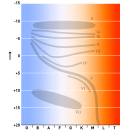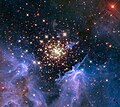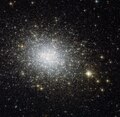The turnoff point for a star refers to the point on the Hertzsprung–Russell diagram where it leaves the main sequence after its main fuel is exhausted –...
2 KB (249 words) - 22:16, 10 December 2023
followed in sequence by stars of ever lower masses. The position where stars in the cluster are leaving the main sequence is known as the turnoff point. By...
61 KB (6,817 words) - 02:48, 18 June 2024
stellar cluster, they have a higher effective temperature than the main sequence turnoff point for the cluster, where ordinary stars begin to evolve towards...
12 KB (1,500 words) - 16:35, 7 July 2024
Star (section Main sequence)
the main sequence turnoff in the cluster to which they belong; in standard stellar evolution, blue stragglers would already have evolved off the main sequence...
146 KB (16,327 words) - 18:46, 12 July 2024
and core masses at the main sequence turnoff. Low metallicity stars develop a larger helium core before leaving the main sequence, hence lower mass stars...
29 KB (3,699 words) - 15:00, 5 June 2024
a "knee" in the H–R diagram called the main-sequence turnoff, bending to the upper right from the main-sequence line. The absolute magnitude at this bend...
105 KB (11,846 words) - 06:42, 22 June 2024
Hertzsprung–Russell diagram for a typical globular cluster. It begins at the main-sequence turnoff point and extends toward the higher luminosity and lower temperature...
160 KB (18,380 words) - 13:30, 5 July 2024
15′. It has an estimated age of 250 million years, based on the main sequence turnoff. A total of 71 variable stars have been detected in the field of...
5 KB (346 words) - 18:37, 18 January 2024
06 Gyr, they are mainly low mass stars on the main sequence or red giants, with a main sequence turnoff at about F0. A blue straggler star is also present...
11 KB (452 words) - 01:43, 26 November 2023
HR diagram showing the main sequence turnoff of NGC 188 and M 67, indicating their relatively high ages...
4 KB (329 words) - 16:58, 10 June 2024
Matthew; Thompson, Jeffery M. (2016-01-01). "Using A New Model for Main Sequence Turnoff Absolute Magnitudes to Measure Stellar Streams in the Milky Way...
25 KB (2,641 words) - 13:37, 5 April 2024
galaxy. The Hertzsprung–Russell diagram for NGC 6388 shows that the main-sequence turnoff for this cluster is similar to that of the cluster 47 Tucanae. This...
18 KB (1,378 words) - 22:48, 24 June 2024
populated cluster of stars (p) with a wide brightness range (3). The main sequence turnoff point is not well-defined, so the age estimates range from five...
7 KB (537 words) - 17:12, 10 June 2024
supergiants, prominent in deep images of the cluster. Together with the main sequence turnoff, these tightly constrain the age of the cluster to 18 million years...
2 KB (197 words) - 12:41, 14 May 2023
(2010). "Kepler-4b: A Hot Neptune-like Planet of a G0 Star Near Main-sequence Turnoff". The Astrophysical Journal Letters. 713 (2): L126–L130. arXiv:1001...
10 KB (793 words) - 01:41, 22 October 2023
Beta Lyrae (category B-type main-sequence stars)
been named Gaia 8. The cluster members are all main sequence stars and the lack of a main sequence turnoff means that a precise age cannot be calculated...
29 KB (2,696 words) - 19:00, 1 April 2024
Kepler-4 (category G-type main-sequence stars)
(2010). "Kepler-4b: A Hot Neptune-like Planet of a G0 Star Near Main-sequence Turnoff". The Astrophysical Journal Letters. 713 (2): L126–L130. arXiv:1001...
14 KB (1,011 words) - 19:57, 9 March 2024
metallicity is very similar to the Sun. It displays an extended main sequence turnoff on the Hertzsprung–Russell diagram, most likely due to differences...
6 KB (529 words) - 22:23, 2 December 2023
Scott Pilgrim vs. the World (section Title sequence)
Nintendo and MTV. Its kinetic nature and quirky sensibilities might be a turnoff for some." Scott also found the youth elements appealing, writing that...
171 KB (18,390 words) - 08:38, 14 July 2024
HD 97950 (category O-type main-sequence stars)
Fitting the main sequence, and pre-main sequence gives a cluster age of 1 million years or less. There is no clear main sequence turnoff, although the...
12 KB (1,251 words) - 20:31, 6 February 2024
Eta Volantis (category A-type main-sequence stars)
aspects of a main sequence star and a subgiant. Stellar evolution models from Zorec and Royer (2012) place it near the main sequence turnoff, having completed...
10 KB (755 words) - 23:55, 8 January 2024
WASP-13 (category G-type main-sequence stars)
from its position in the Hertsprung-Russel diagram is near the main sequence turnoff, and it is considered very close to exhausting its core hydrogen...
10 KB (891 words) - 07:25, 9 May 2024
doi:10.1086/114007. Stryker, L. L.; et al. (November 1985). "The main-sequence turnoff of the old SMC globular cluster NGC121". Astrophysical Journal....
11 KB (970 words) - 06:19, 22 June 2024
14±2 million years. Clusters of this age are expected to have a main sequence turnoff at spectral type B1, and this is seen in NGC 7419. 1,200 M☉ of B-type...
9 KB (941 words) - 03:29, 14 March 2024
T Antliae. Fitting of isochrones to the brighter stars shows a main sequence turnoff consistent with the position of T Antliae in the H-R diagram. The...
6 KB (651 words) - 13:47, 9 March 2021
thought to be exchanging mass and their luminosity classes match the main sequence turnoff in the Cyg OB2 association at around O6. The nearby stars Cyg OB2...
8 KB (634 words) - 00:41, 16 May 2024
HD 21693 (category G-type main-sequence stars)
right at the end of the main sequence, on the hook before the subgiant turnoff, with a mass of 0.90 M☉ and an age of around 7 billion years, although...
11 KB (1,171 words) - 23:44, 14 August 2023
DS Andromedae (category G-type main-sequence stars)
Its age can be determined at 2.0±0.2 Gyr from the NGC 752 main sequence turnoff and this allows its physical properties to be accurately calculated. It...
11 KB (673 words) - 13:21, 9 May 2024
and the dimmest turnoff point of main sequence stars in clusters (lower-mass stars spend a greater amount of time on the main sequence, so the lowest-mass...
34 KB (3,970 words) - 15:24, 23 June 2024
speeding Chevrolet Chevelle when his father, Reese, accidentally misses the turnoff for the hospital. Ricky sees his father only once after that, at age 10...
34 KB (3,943 words) - 18:25, 8 July 2024






















